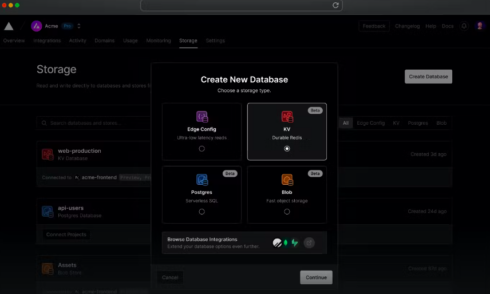
Vercel announced its suite of serverless storage solutions: Vercel KV, Postgres, and Blob to make it easier to server render just-in-time data as part of the company’s efforts to “make databases a first-class part of the frontend cloud.”
Vercel KV is a serverless Redis solution that’s easy and durable, powered by Upstash. With Vercel KV, it’s possible to generate Redis-compatible databases that can be written to and read from Vercel’s Edge Network in regions that you designate, requiring only minimal configuration.
Vercel Postgres is a serverless SQL database built for the frontend, powered by Neon. Vercel Postgres provides a completely managed, fault-tolerant, and highly scalable database that offers excellent performance and low latency for web applications. It’s specifically designed to work flawlessly with Next.js App Router and Server Components, as well as other frameworks like Nuxt and SvelteKit. This makes it easy to retrieve data from your Postgres database and use it to create dynamic content on the server with the same rapidity as static content.
Lastly, Vercel Blob enables users to upload and serve files at the edge, and is powered by Cloudflare R2. Vercel Blob can store files like images, PDFs, CSVs, or other unstructured data and it’s useful for files normally stored in an external file storage solution such as Amazon S3, files that are programmatically uploaded or generated in realtime, and more.
“Frameworks have become powerful tools to manipulate backend primitives. Meanwhile, backend tools are being reimagined as frontend-native products. This convergence means bringing data to your application is easier than ever, and we wanted to remove the final friction point: getting started,” Vercel stated.
Vercel KV, Vercel Postgres, and Vercel Blob are built on open standards and protocols, designed for low latency, efficient data fetching, and fully integrated with Vercel’s existing tools and workflows.
Additional details are available here.






